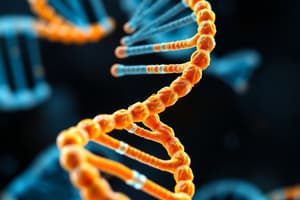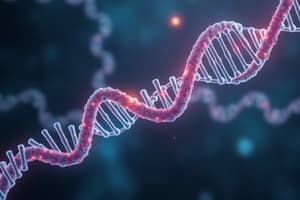Podcast
Questions and Answers
What sugar is found in the nucleotides of DNA?
What sugar is found in the nucleotides of DNA?
- Deoxyribose (correct)
- Fructose
- Glucose
- Ribose
Which nitrogenous base replaces thymine in RNA?
Which nitrogenous base replaces thymine in RNA?
- Uracil (correct)
- Guanine
- Adenine
- Cytosine
What is the structural shape of DNA called?
What is the structural shape of DNA called?
- Circular loop
- Single strand
- Beta-pleated sheet
- Double helix (correct)
How do DNA strands run relative to each other?
How do DNA strands run relative to each other?
What enzyme unwinds the DNA during replication?
What enzyme unwinds the DNA during replication?
What direction does DNA polymerase read the template strand during replication?
What direction does DNA polymerase read the template strand during replication?
Which strand of DNA is replicated continuously during DNA replication?
Which strand of DNA is replicated continuously during DNA replication?
What type of bond holds the nitrogenous bases together in DNA?
What type of bond holds the nitrogenous bases together in DNA?
What is the primary role of messenger RNA (mRNA)?
What is the primary role of messenger RNA (mRNA)?
What is the role of transfer RNA (tRNA) in gene expression?
What is the role of transfer RNA (tRNA) in gene expression?
How does gene expression affect phenotype?
How does gene expression affect phenotype?
What initiates the transcription process in eukaryotic cells?
What initiates the transcription process in eukaryotic cells?
What happens to mRNA after transcription during the editing process?
What happens to mRNA after transcription during the editing process?
What is the significance of alternative RNA splicing?
What is the significance of alternative RNA splicing?
How is mRNA regulated after transcription?
How is mRNA regulated after transcription?
What characterizes proteins that have both inactive and active forms?
What characterizes proteins that have both inactive and active forms?
What is the role of DNA ligase in DNA replication?
What is the role of DNA ligase in DNA replication?
What is the first step of transcription?
What is the first step of transcription?
Why are Okazaki fragments formed during DNA replication?
Why are Okazaki fragments formed during DNA replication?
What happens during the termination phase of transcription?
What happens during the termination phase of transcription?
What is the end product of transcription?
What is the end product of transcription?
During translation, what sequence of nucleotides is recognized as a START codon?
During translation, what sequence of nucleotides is recognized as a START codon?
Which component of the tRNA corresponds to the mRNA codon?
Which component of the tRNA corresponds to the mRNA codon?
What does the cap and tail of mRNA do?
What does the cap and tail of mRNA do?
In protein synthesis, what role do codons play?
In protein synthesis, what role do codons play?
What is the purpose of alternative RNA splicing?
What is the purpose of alternative RNA splicing?
How does gene regulation affect gene expression?
How does gene regulation affect gene expression?
What differentiates the leading strand from the lagging strand during DNA replication?
What differentiates the leading strand from the lagging strand during DNA replication?
Which of the following correctly signifies an error in transcription?
Which of the following correctly signifies an error in transcription?
What is the role of transfer RNA (tRNA) in translation?
What is the role of transfer RNA (tRNA) in translation?
Flashcards
Gene Expression
Gene Expression
The process of converting genetic information from DNA to proteins.
mRNA
mRNA
Messenger RNA that transcribes genes and carries the message to ribosomes for protein synthesis.
tRNA
tRNA
Transfer RNA that translates mRNA codons into amino acids during translation.
Alternative RNA Splicing
Alternative RNA Splicing
Signup and view all the flashcards
Transcription Factors
Transcription Factors
Signup and view all the flashcards
Introns and Exons
Introns and Exons
Signup and view all the flashcards
Regulation of Gene Expression
Regulation of Gene Expression
Signup and view all the flashcards
Active vs Inactive Proteins
Active vs Inactive Proteins
Signup and view all the flashcards
Nucleic Acids
Nucleic Acids
Signup and view all the flashcards
Nucleotides
Nucleotides
Signup and view all the flashcards
DNA Bases
DNA Bases
Signup and view all the flashcards
Complementary Bases
Complementary Bases
Signup and view all the flashcards
Semiconservative Replication
Semiconservative Replication
Signup and view all the flashcards
Antiparallel Strands
Antiparallel Strands
Signup and view all the flashcards
Leading Strand
Leading Strand
Signup and view all the flashcards
Lagging Strand
Lagging Strand
Signup and view all the flashcards
Antiparallel DNA
Antiparallel DNA
Signup and view all the flashcards
Okazaki fragments
Okazaki fragments
Signup and view all the flashcards
DNA ligase
DNA ligase
Signup and view all the flashcards
Replication bubbles
Replication bubbles
Signup and view all the flashcards
Transcription
Transcription
Signup and view all the flashcards
Promoter
Promoter
Signup and view all the flashcards
Post-transcriptional modification
Post-transcriptional modification
Signup and view all the flashcards
Translation
Translation
Signup and view all the flashcards
Codon
Codon
Signup and view all the flashcards
Gene regulation
Gene regulation
Signup and view all the flashcards
Study Notes
Nucleic Acids and DNA Structure
- DNA and RNA are nucleic acids composed of nucleotides.
- Nucleotides consist of a phosphate group, a sugar (deoxyribose in DNA, ribose in RNA), and a nitrogenous base.
- DNA contains four nitrogenous bases: adenine (A), thymine (T), guanine (G), and cytosine (C).
- A always bonds with T, and G always bonds with C.
- RNA has uracil (U) instead of thymine (T), which bonds with adenine (A).
- Both DNA and RNA have a covalently bonded sugar-phosphate backbone.
- DNA is double-stranded, forming a double helix. RNA is single-stranded.
- The sugar-phosphate backbone forms the sides of the DNA "ladder," while the nitrogenous bases form the rungs, held together by hydrogen bonds.
DNA Replication
- DNA replicates during cell division, using each strand as a template to create a new strand.
- The resulting DNA molecule contains one original (parent) strand and one new (daughter) strand (semiconservative replication).
- DNA strands run antiparallel (3' to 5' and 5' to 3').
- One end of a DNA strand has a phosphate group, and the other has a sugar.
Leading Strand Replication
- DNA helicase unwinds the DNA double helix.
- RNA primase creates a short RNA primer.
- DNA polymerase reads the template strand in the 3' to 5' direction and builds the new strand in the 5' to 3' direction.
- This allows for continuous replication on the leading strand.
Lagging Strand Replication
- DNA polymerase cannot continuously replicate the lagging strand (which runs 5' to 3'), so it moves in short fragments called Okazaki fragments.
- RNA primase adds primers to initiate each Okazaki fragment.
- DNA polymerase adds DNA nucleotides to each Okazaki fragment.
- DNA ligase joins the Okazaki fragments to form a complete new strand.
Replication Initiation Sites
- Replication begins at multiple sites along the DNA molecule to increase speed. These sites create replication bubbles.
Transcription
- Genes contain the code for proteins.
- DNA, which contains the genetic code, cannot leave the nucleus.
- RNA carries the genetic code from the nucleus to the ribosomes.
- Transcription analogous to copying architectural plans for a new construction.
- The process is initiated, elongated, and terminated. These three phases are: Initiation, elongation, and termination.
Transcription Initiation
- DNA helicase unwinds the DNA helix.
- RNA polymerase binds to the promoter (a region of DNA at the gene's start).
Transcription Elongation
- RNA polymerase moves along the template strand, building a complementary RNA strand.
- RNA uses uracil (U) instead of thymine (T).
Transcription Termination
- RNA polymerase reaches the terminator sequence (end of the gene).
- RNA polymerase detaches, and the DNA rewinds
Post-transcriptional Modifications
- mRNA capping: A modified guanine is added to the 5' end.
- Polyadenylation: A poly-A tail (~250 adenine nucleotides) is added to the 3' end for protection from cellular enzymes.
- Alternative splicing: Introns (non-coding regions) are removed from the mRNA, and exons (coding regions) are joined.
Translation
- RNA (mRNA) nucleotides are translated into amino acids.
- mRNA, in sets of three nucleotides called codons, provides the instructions.
- Transfer RNA (tRNA) carries amino acids to the ribosomes.
- A codon is a sequence of three nucleotides specifying an amino acid. Each codon corresponds to a single amino acid
- A codon wheel is used to determine the amino acid sequence
- Translation occurs in ribosomes and involves three phases: Initiation, elongation, and termination.
Translation Initiation
- mRNA binds to a ribosome.
- The start codon (usually AUG) initiates translation.
- A tRNA molecule with the corresponding amino acid binds to the start codon.
Translation Elongation
- tRNA bringing the next amino acid binds to the A site of the ribosome
- Peptide bonds form between the amino acids connected to the tRNA
- The ribosome moves along the mRNA, adding amino acids to the growing polypeptide chain.
Translation Termination
- When a stop codon is reached, translation stops,
- The polypeptide chain is released.
Gene Regulation
- Gene expression is the process of turning genes on or off to control protein production.
- Gene regulation does not change DNA sequence (genotype).
- It controls whether or not a protein is produced (phenotype).
- Gene regulation is crucial and a precise control mechanism. Gene expression helps coordinate cellular activities and processes in many different organisms.
Cell Differentiation
- Cells differentiate to become specialized cell types during development.
- All cells have the same DNA, but different genes are expressed in different cells.
- Gene regulation is essential for differentiation.
Eukaryotic Transcription Regulation
- Transcription in eukaryotic cells relies on transcription factors which bind to the DNA enhancer sequence.
- The DNA folds, locking RNA polymerase into position on the promoter to start transcription.
Post-Transcriptional Gene Regulation
- mRNA can be broken down or last for a while depending on how often that protein's gene needs to be expressed.
- Some proteins have inactive and active forms changing how they function.
Studying That Suits You
Use AI to generate personalized quizzes and flashcards to suit your learning preferences.





